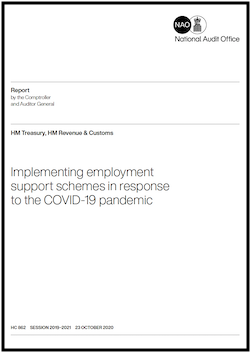NAO report on Coronavirus job support schemes
This report examines the role of HM Treasury and HM Revenue & Customs (HMRC) in implementing the Coronavirus Job Retention Scheme (CJRS) and the Self-Employment Income Support Scheme (SEISS). The report considers how well the schemes were implemented, recognising the need to deliver at speed in response to the COVID-19 pandemic.
The report looks at the implementation of the Coronavirus Job Retention Scheme (CJRS) and the Self-Employment Income Support Scheme (SEISS). This report considers whether the Departments have:
- managed design and delivery risks effectively in implementing the schemes. Part One assesses the Departments’ implementation of these schemes against evaluative criteria that draw upon our work analysing the government’s response to other crises;
- understood whether the schemes are reaching the people intended. Part Two examines the Departments’ approach to ensuring that the schemes were reaching their intended recipients, whether they had a good understanding of the consequences of their design decisions and what the impact of those decisions has been; and
- managed fraud and error risks effectively. Part Three considers how far fraud and error risks have been addressed.
Findings
The report finds that:
Designing and implementing the employment support schemes
- The Departments implemented the schemes quickly and ahead of schedule.
- The scale of the challenge was potentially increased by the lack of pandemic contingency planning and existing employment support schemes the Departments could easily adapt.
- Given the compressed timeframe to design each scheme, the Departments could not follow standard processes comprehensively.
- HMRC implemented the schemes quickly through strong project management, risk management and service testing.
- Other countries, at the start of the pandemic, were able to adapt existing schemes to deliver support more quickly.
Supporting the people intended
- The schemes have been largely successful in protecting jobs through the lockdown period, with at least 12.2 million people benefitting from support.
- A combination of policy decisions and constraints in the tax system meant that as many as 2.9 million people were not eligible for the schemes.
- The Departments considered the equality implications of their design decisions.
- In the long-term the number of jobs protected will depend on wider government support.
Managing fraud and error
- In implementing the schemes, the Departments accepted there may be a higher risk of fraud and error than normal, in order to provide rapid financial support and protect jobs.
- There is evidence that significant levels of furlough fraud occurred, with limited controls over employers’ arrangements with employees.
- The scale of total fraud and error is likely to be considerable, particularly for CJRS, but HMRC will not know the actual levels for some time.
- HMRC’s initial assessment was that it must divert resources from tax compliance activities to tackle fraud on these schemes.
Conclusion on value for money
HM Treasury and HMRC met their objective to rapidly implement the schemes and the Departments should be commended for making these available ahead of schedule. The schemes were relatively straightforward to apply for, and payments quickly reached those who applied. Indications are that this has helped to protect jobs in the short term and the numbers of people moving from furlough arrangements back to work are encouraging. However, many other people have lost earnings and have not been able to access support. The long-term impact
of the schemes will also depend on wider financial support and the ongoing impact of COVID-19.

